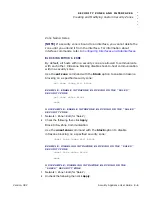
. . . . .
S E C U R I T Y Z O N E S A N D I N T E R F A C E S
Configuring Interface Modes
Version 3R2
Security Appliance User Guide
3-17
In order to manage the freeGuard Blaze 2100 through the network, you
must configure a management interface. In Transparent mode, the
logical management interface, br0, is utilized.
[NOTE]
On the 2-port appliances, br0 represents both eth0 and eth1 as
a logical interface and is specifically designed to be used for
management traffic while in Transparent mode.
[NOTE]
On all other appliances with 8 ports, this translates to 4 bridge
ports. br0 (eth0 and eth4), br1 (eth1 and eth5), br2 (eth2 and eth6),
and br3 (eth3 and eth7). These ports can configured independently
(eth0 and eth4 in Transparent mode, eth1/2/3/5/6/7 in Route/Nat mode
or you can configure all 4 bridge ports in a complex Transparent mode
design). These bridge-to-ports assignments are hard-coded within the
appliance and cannot be modified.
In addition to configuring the br0 management interface, a default route
is required to be configured in order for the freeGuard Blaze 2100 to
communicate to host/s that are outside its immediate network subnet.
For example if SNMP or SSH is required from a host that is somewhere
on the Internet, the freeGuard Blaze 2100 will need a route configured to
the default gateway. If the host requesting the management traffic exists
somewhere deep within the LAN network, a static route may have to be
added.
Note: br0 responds to request on both the Untrust and Trust zone and
therefore if filtering of the management request is required then the
Manage-ip function should be used.
Following is the CLI example for
Figure 3-9
:
set zone name Accounting
set zone name Finance
set interface eth0 ip 0.0.0.0/0
set interface eth0 transparent
set interface eth0 zone trust
set interface eth1 ip 0.0.0.0/0
set interface eth1 transparent
set interface eth1 zone untrust
set interface br0 ip 10.0.0.254/24
set interface br0 manage ping












































